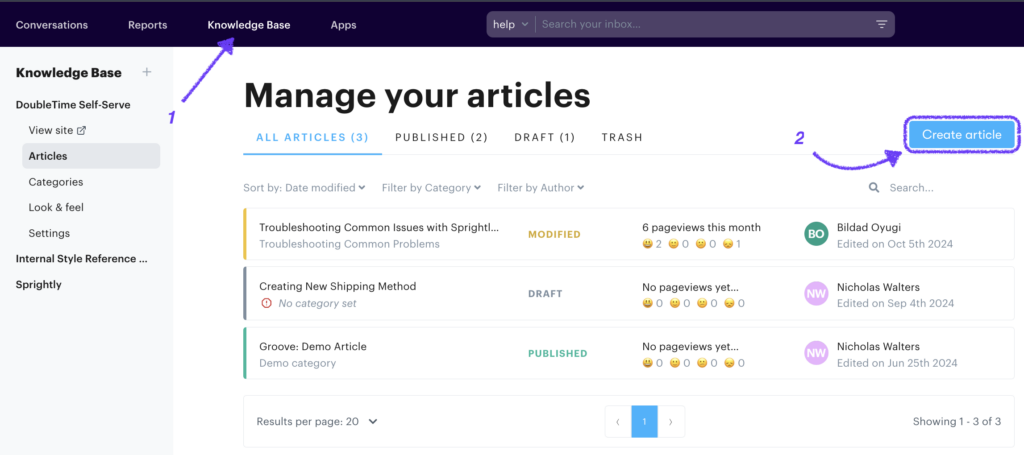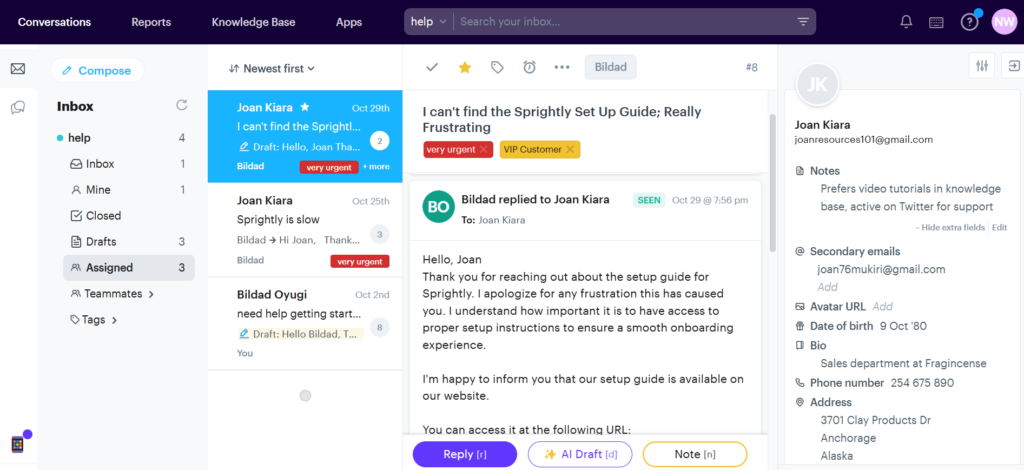You’ve built an amazing SaaS product, but now you’re drowning in a sea of customer queries. Your support team is getting sidetracked by repetitive tickets, the churn rate is creeping up, and you’re losing sleep over missed follow-ups.
Sound familiar?
In the fast-paced world of SaaS, stellar customer support isn’t just nice to have—it’s critical for survival. That means you need SaaS helpdesk software that speaks your language. But choosing the right one can be a daunting task.
You’ll need to cut through the noise and focus on what truly matters for your business. To help, we’ve put together a roadmap to selecting the perfect SaaS customer service platform – from must-have features to scalability.
The goal? Finding a tool that not only solves today’s support headaches, but also fuels tomorrow’s growth. Let’s dive right in!
Step 1: Assess Your Support Needs
Choosing the right SaaS helpdesk software starts with some reflection. Your support needs are likely different from more traditional companies. You’re not just handling one-time purchases; you’re nurturing ongoing relationships with subscribers.
Here’s how you can put together a summary of your business’ support needs:
- Gather insights from your front-line support team. Break down the challenges your support agents face daily. Understanding these pain points is crucial, because they’ll guide you towards a helpdesk solution that truly addresses your team’s needs.
- Review your most common support tickets. The complexity and types of issues you typically handle will influence the features you require from your SaaS helpdesk software. Are most problems one-and-done? Do you do a lot of in-depth troubleshooting?

- Closely look at your customer lifecycle. Pay attention to how support needs evolve from initial onboarding through to renewal and retention. You need a platform that can adapt to the different stages of your customers’ journeys, ensuring consistent and relevant support at each step.
- Consider how frequently you update your product. If you’re pushing out new features regularly, you’ll need a helpdesk that can keep pace with version-specific support and feature announcements.
Step 2: Consider What Other Tools Your Support Team Uses
You likely rely on a variety of tools to manage operations, from subscription billing systems to product analytics platforms. Your new helpdesk shouldn’t exist in isolation.
Instead, it should integrate with the other platforms your service team uses regularly. Don’t force them to switch around between dashboards, and hunt for customer data in multiple spots. Make their jobs easier by bringing as many tasks and communication channels as possible together in one place.
A few tips for evaluating a helpdesk’s integration capabilities:
- Check compatibility with your subscription management system. Your support team shouldn’t have to juggle multiple tabs to help a single customer.
- As an example, our own helpdesk Groove integrates with Stripe, allowing support agents to view and manage subscription details directly from your shared inbox. This streamlines billing queries and upgrade processes.

- Assess integration with product analytics tools. Wouldn’t it be great if your support team could see how customers are using your product? A helpdesk that talks to your analytics tools can provide this valuable context. This lets your agents troubleshoot more effectively, and spot opportunities for customer success.
- Examine connections with other key SaaS tools. Consider how the helpdesk works with other essential tools in your stack, like your CRM or development tracking software. The more integrated your systems are, the more efficient your support operations will be. This holistic approach turns your helpdesk into a central hub for customer insights.
- Test the quality of integrations during trials. Take advantage of free trials to set up and test integrations with your most critical tools. How smoothly does data flow between systems? Does the integration feel like a natural extension of your workflow, or a clunky add-on? Hands-on experience gives you the clearest picture of how the helpdesk will function in your unique environment.
By prioritizing strong integration capabilities, you’re setting your team up to provide the kind of seamless and informed SaaS support that keeps customers coming back for more.
Step 3: Analyze Self-Service Options for Customers
Since your users stick around long-term (hopefully!), you have to provide more ongoing support than other businesses. This threatens to take up a lot of valuable time for both you and your customers.
Streamlining is vital. And one of the best ways to do that is by empowering your SaaS customers to find answers on their own. The more they can problem-solve independently, the quicker they get what they need. And the less time your team spends answering the same basic inquiries over and over again.
Does the SaaS helpdesk software you’re looking at provide the right self-service options? We’d recommend taking the time to:
- Examine the knowledge base features. Look for functionality that allows you to easily create, organize, and update articles. A well-structured knowledge base can significantly reduce ticket volume, and improve customer satisfaction.
- Assess the search functionality. How intuitive and powerful is the search feature? Can customers easily find relevant articles based on their queries? Look for features like auto-suggest and natural language processing that guide users to the right information quickly.
- Check for version-specific content capabilities. As a SaaS provider, you likely have multiple versions of your product. Can the helpdesk’s self-service options cater to this? Look for features that allow customers to access information specific to their versions of your software, to ensure that they always get relevant and accurate help.
Because so many of our customers are SaaS businesses, we’ve designed Groove’s knowledge base to do all of this and more.

The technical and design work is handled for you, no setup required. All your team needs to do is write and publish useful articles, then organize them into a clear system, and you’ll have a whole new support stream available.
By focusing on self-service, you’re not just reducing the load on your support team. You’re also enhancing customer satisfaction by providing immediate and accessible support.
Step 4: Consider Scalability and Future Plans
One day you’re celebrating your 100th customer, and before you know it, you’re managing thousands. And it’s not much fun to switch platforms when you’re that busy.
So you’ll need SaaS helpdesk software that can scale with your business. After all, the last thing you want is to outgrow your support system just when you need it most. Better to set everything up in a robust way now.
How do you ensure that your chosen helpdesk can keep up with your ambitious growth plans?
- Assess handling of sudden user base increases. How does the helpdesk perform under increased load? Look for information on how the system handles spikes in ticket volume. Can it automatically distribute workload, or provide queue management features?
- Check for easy team expansion options. Look for features like role-based access controls and easy user management. The ability to quickly onboard new support staff and assign appropriate permissions is vital when your business is growing rapidly.
- Examine knowledge sharing capabilities. Features like internal notes, mentions, and collaborative tools maintain consistency and efficiency as your support team expands.

- Analyze reporting tools for growing operations. As you scale, you’ll need robust analytics to track performance. That means monitoring key metrics, identifying trends, and making data-driven decisions as your support operations grow.
- Evaluate the pricing model’s flexibility. Look for transparent pricing that doesn’t penalize success. Some helpdesks offer tiered pricing, or allow you to add users or features incrementally. This flexibility manages costs while scaling your support operations.
At Groove, we’ve built our pricing model with growing SaaS businesses in mind. Our transparent, tiered pricing structure allows you to add users or features easily as your business expands.
Whether you opt for Groove or another platform, this is the time to think about the future. Are you getting what your team needs now, and what they’re likely to need in a year or two?
Step 5: Test the SaaS Helpdesk Software With Real-World Scenarios
Choosing a helpdesk isn’t just about ticking off feature boxes. It’s about making sure the platform can handle the unique challenges of your SaaS business.
That’s why putting your potential helpdesk through its paces with real-world scenarios is crucial. Here’s how you can conduct effective tests:
- Simulate technical queries. How well does the helpdesk handle complex, technical issues? Try creating a ticket that mimics a tricky bug report or a complicated feature question. Then see how easy (or hard) it is for agents to collaborate, escalate issues, or loop in your development team when needed.
- Evaluate feature request management. Can the helpdesk effectively track and manage feature requests? Test how it handles categorizing, prioritizing, and following up on these requests. This is crucial for keeping your product development aligned with customer needs.
- Assess onboarding workflow management. How does the helpdesk support customer onboarding? Test creating and managing onboarding tasks, setting up automated check-ins, and tracking a customer’s progress through the onboarding process.

- Test version-specific support capabilities. If you offer variations of your product, how well does the helpdesk handle version-specific issues?
- Try out subscription and billing support. Can the helpdesk effectively handle subscription and billing queries? Test scenarios like upgrading a plan, handling a billing dispute, or managing a subscription pause.
By running through these scenarios, you’ll get a much clearer picture of how the SaaS helpdesk software will perform in your day-to-day operations. This also means you’re looking for solutions that offer free tiers or trials, so you can get some real hands-on experience before you commit.
Transform SaaS Support from an Obligation into a Superpower
Here’s our #1 tip: Don’t settle for a one-size-fits-all solution. You’ve toiled hard to build a unique SaaS product, right? You deserve a helpdesk that’s just as innovative and purpose-built.
What if your support team wasn’t just solving tickets, but actively driving growth? Every interaction is an opportunity to deepen customer relationships and unlock new value. To make the most of those touchpoints, you need a helpdesk that anticipates needs, streamlines workflows, and turns data into actionable insights.
In other words, you need a platform that truly understands the SaaS landscape. And that’s exactly what we’ve built with Groove.
From seamless integrations with your SaaS stack to streamlined features for organization and prioritization, Groove elevates your support from a cost center to a revenue generator.
Your customers are waiting. Your team is ready. Let’s revolutionize SaaS support together with Groove. Start your free trial today!





